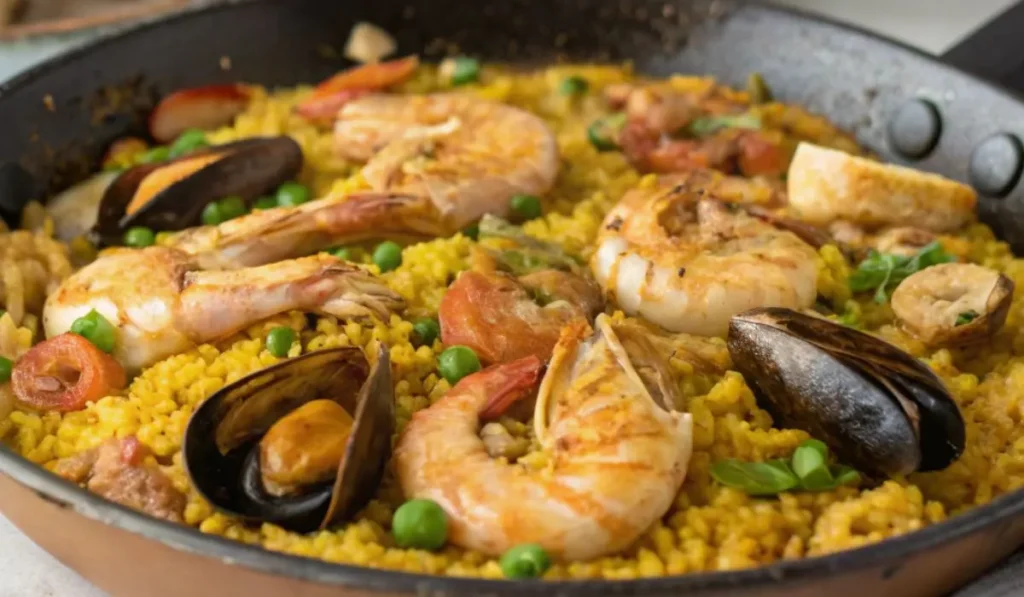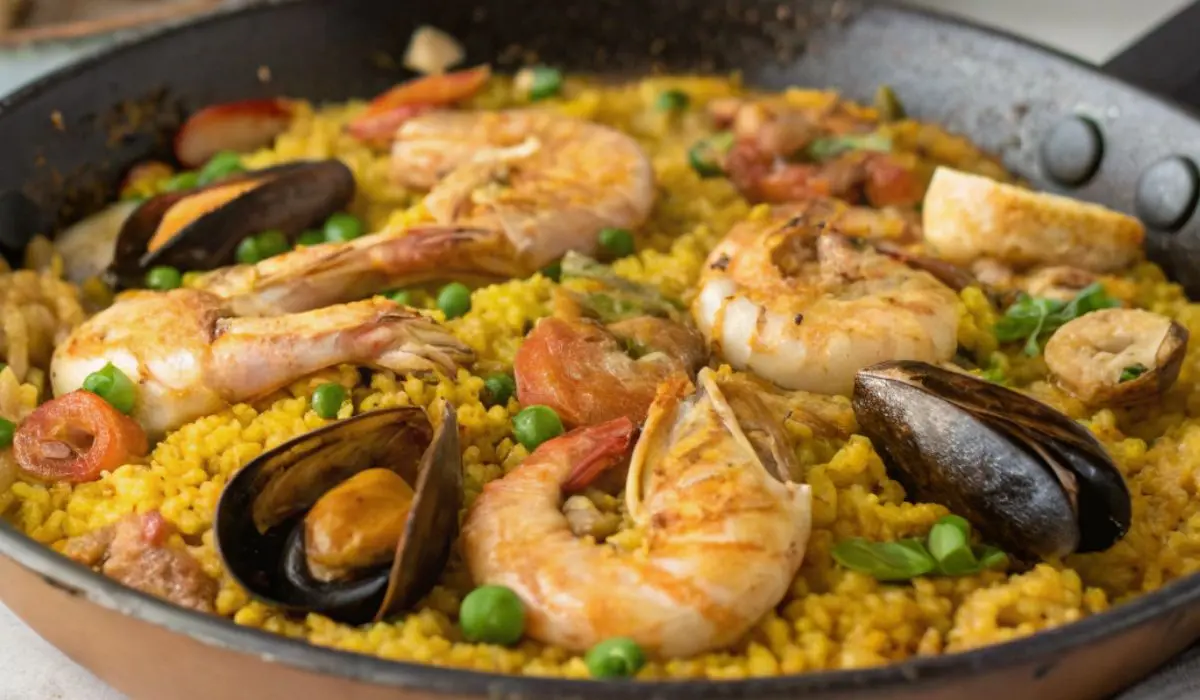This authentic paella recipe brings Spain’s most beloved dish to your kitchen with simple ingredients and clear instructions. Paella combines rice, saffron, chicken, seafood, and vegetables in one pan to create a flavorful meal that feeds a crowd.
Traditional Spanish paella originated in Valencia but has become the national dish of Spain. You can make this restaurant-quality dish at home without special equipment or hard-to-find ingredients.

Essential Paella Ingredients
Spanish paella relies on key ingredients that create its distinctive flavor and texture:
- Rice. Spanish bomba rice works best, but medium-grain rice like Calrose makes a good substitute
- Saffron. The most important spice that gives paella its golden color and unique taste
- Proteins. Chicken thighs, jumbo shrimp, mussels, and calamari rings
- Vegetables. Onion, bell peppers, garlic, tomatoes, and frozen peas
- Seasonings. Bay leaf, paprika, salt, pepper, and fresh parsley
- Liquids. Chicken broth, white wine, and olive oil
The secret to authentic paella lies in using high-quality saffron. This spice may cost more than others, but it creates the signature flavor that makes paella special.
Step-by-Step Paella Instructions
Making paella follows a specific process that builds flavors layer by layer:
1. Prepare the Base
- Heat olive oil in a large skillet over medium heat
- Add diced onion, bell peppers, and minced garlic
- Cook until onions turn translucent, about 5 minutes
- Stir in chopped tomatoes, bay leaf, paprika, and saffron
- Season with salt and pepper, then cook for 5 more minutes
2. Add Wine and Proteins
- Pour white wine into the pan and let it cook for 10 minutes
- Add chicken pieces and 2 tablespoons of chopped parsley
- Stir in the rice and cook for 1 minute to toast slightly
3. Cook the Rice
- Pour chicken broth slowly around the entire pan
- Shake the pan gently to distribute rice evenly
- Never stir the rice once you add the broth
- Bring to a boil, then reduce heat to medium-low
- Cook uncovered for 15-18 minutes
4. Add Seafood
- Nestle shrimp, mussels, and calamari into the rice
- Sprinkle frozen peas over the surface
- Continue cooking for 5 more minutes without stirring
- Watch for liquid absorption and tender rice
5. Rest and Serve
- Remove from heat and cover with a lid or foil
- Place a kitchen towel over the lid
- Let rest for 10 minutes before serving
- Garnish with fresh parsley and lemon slices
Choosing the Right Rice
Rice selection makes or breaks your paella. Spanish bomba rice absorbs liquid without becoming mushy, creating the perfect texture. This short-grain variety holds its shape while developing the crispy bottom layer called socarrat.
If you cannot find Spanish rice, use medium-grain rice like Calrose. Reduce the broth to 3¾ cups when using this substitute. Avoid long-grain rice or arborio rice, as they do not work well for paella.
Never wash paella rice before cooking. The natural starch coating helps create the proper texture and the coveted socarrat crust.
Seafood Selection Tips
Fresh seafood transforms good paella into exceptional paella:
- Smell test. Fresh seafood should smell like the ocean, not fishy
- Preparation. Remove beards from mussels and clean properly
- Frozen options. Thaw overnight in the refrigerator before using
- Variety. Mix shrimp, mussels, calamari, clams, or scallops
Many grocery stores sell frozen seafood mixes perfect for paella. These provide convenience without sacrificing quality, especially if you live away from coastal areas.
Equipment and Pan Options
You do not need a traditional paella pan to make authentic paella. A large 12-inch skillet works perfectly for home cooking. The key is using a wide, shallow pan that allows rice to spread in a thin layer.
Cast iron skillets retain heat well and help develop the socarrat crust. Stainless steel pans also work but may require more attention to prevent sticking.
Popular Paella Variations
Traditional paella recipes offer flexibility for different tastes:
Paella Valenciana
- Features rabbit, chicken, green beans, and artichokes
- Represents the original Valencia-style recipe
- Uses local ingredients from the Valencia region
Seafood Paella
- Contains only seafood and vegetables
- Popular in coastal Spanish regions
- Perfect for seafood lovers
Vegetarian Paella
- Replaces meat with mushrooms, artichokes, and green beans
- Adds olives and asparagus for extra flavor
- Maintains authentic Spanish taste without animal products
Mixed Paella
- Combines chicken, seafood, and vegetables
- Most popular version served in restaurants
- Offers the best variety of flavors and textures
Pro Tips for Perfect Paella
Success with paella comes from following traditional techniques:
- Never stir the rice after adding broth
- Listen for gentle sizzling to know the socarrat is forming
- Taste and adjust seasoning before adding seafood
- Use a timer to avoid overcooking
- Let the paella rest before serving for best texture
The socarrat, or crispy bottom layer, is considered the prize of good paella. This golden crust develops naturally when you avoid stirring and use proper heat control.
Serving and Storage
Paella serves 6 people as a main course. Present it directly from the cooking pan for authentic Spanish style. Provide lemon wedges and let diners squeeze fresh citrus over their portions.
Leftover paella keeps in the refrigerator for 2-3 days. Reheat gently in a covered pan with a splash of broth to restore moisture. The rice texture changes slightly when reheated, but the flavors remain delicious.
This traditional Spanish paella recipe brings authentic Mediterranean flavors to your dinner table. With practice, you will master this iconic dish that impresses family and guests alike.

Best Spanish Paella
Ingredients
Equipment
Method
- Prepare the base: Heat olive oil in a large 12-14 inch skillet over medium heat. Add diced onion, bell peppers, and minced garlic. Cook until onion becomes translucent, about 5 minutes.
- Add aromatics: Stir in finely diced tomatoes, bay leaf, paprika, saffron, salt, and pepper. Cook for 5 minutes, stirring occasionally to develop flavors.
- Deglaze with wine: Pour in white wine and cook for 10 minutes, allowing alcohol to evaporate and flavors to concentrate. Taste and adjust seasoning with salt if needed.
- Add proteins and rice: Add chicken pieces and 2 tablespoons of chopped parsley to the pan. Stir in the rice and cook for 1 minute to lightly toast the grains.
- Add broth: Pour chicken broth slowly around the entire pan, distributing evenly. Gently shake the pan to settle rice into an even layer. Important: Do not stir the rice from this point forward!
- Cook the paella: Bring mixture to a boil, then reduce heat to medium-low. Cook uncovered for 15-18 minutes. Give the pan a gentle shake once or twice during cooking, but never stir.
- Add seafood: Nestle shrimp, mussels, and calamari into the rice mixture. Sprinkle frozen peas evenly over the surface. Continue cooking for 5 more minutes without stirring.
- Check for doneness: Watch for most liquid to be absorbed and rice at the top to be nearly tender. Listen for gentle crackling sounds indicating the socarrat (crispy bottom) is forming. If rice seems undercooked, add ¼ cup more broth and continue cooking.
- Rest the paella: Remove pan from heat and cover with a lid or aluminum foil. Place a clean kitchen towel over the lid and let rest for 10 minutes to finish cooking with residual heat.
- Serve: Remove cover and garnish with remaining fresh parsley and lemon wedges. Serve directly from the pan, allowing diners to scrape up some of the prized socarrat with their portions.
